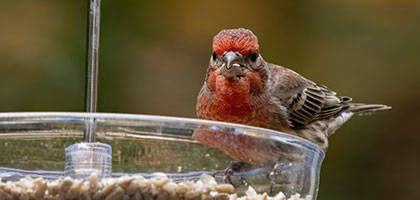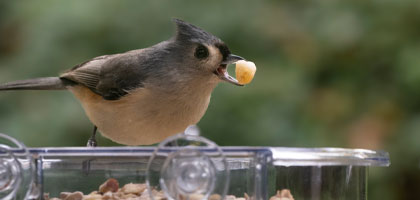Feeding birds can be a rewarding experience. It allows us to connect with nature and observe wildlife up close.
But what should we feed them? Can we put fruit out for birds?
The answer is yes, but with some considerations. Not all fruits are safe or beneficial for our feathered friends.
In this article, we'll explore the types of fruit you can safely offer to birds. We'll also discuss how to do so responsibly, ensuring the health and safety of the birds we love.
Understanding the Benefits of Fruit for Birds
Fruit can be a wonderful addition to a bird's diet. It offers a variety of vitamins and nutrients crucial for their well-being.
Birds benefit from the natural sugars in fruit, providing them with quick energy. This helps sustain them during long flights or colder months.
Feeding birds fruit also helps them diversify their diet. A variety of fruits can complement traditional seeds and grains.
Here are some benefits of feeding birds fruit:
- Essential Nutrients: Fruits are rich in vitamins and antioxidants.
- Natural Sugars: Provides quick energy for daily activities.
- Dietary Variety: Adds diversity to a bird's food intake.
Incorporating fruit into their diet supports their overall health and vitality. But, it’s important to choose fruits that are beneficial and safe for consumption.
Safe Fruits for Your Feathered Friends
When it comes to feeding birds, not all fruits are created equal. It's crucial to know which fruits are safe and nutritious.
Some fruits can be harmful due to seeds, pits, or certain chemicals. For instance, apple seeds contain trace amounts of cyanide and should be avoided.
To feed birds safely, remove seeds, pits, and cores from fruits. This helps prevent poisoning and choking incidents.
Here is a list of safe fruits for birds:
- Apples (without seeds)
- Oranges
- Berries (like blueberries and raspberries)
- Bananas
- Grapes
Remember to always wash fruits thoroughly. This removes pesticides and other chemicals which can harm birds.
Additionally, overripe fruits are a better choice as they are softer and more digestible. Offering fruit in small, manageable pieces makes it easier for birds to enjoy.
The Dos and Don'ts of Feeding Fruit to Birds
When feeding fruit to birds, there are important guidelines to follow. This ensures their health and enjoyment.
Do offer a variety of fruits. Different fruits provide a range of nutrients and flavors for birds.
Don’t give fruits in excess. Too much fruit can lead to digestive issues or discourage natural foraging.
Do cut fruits into small pieces. This minimizes choking hazards and makes the fruit easy to handle.
Don’t offer fruits with high sugar content too often. They can disrupt the birds' balanced diet.
Do clean feeders and areas where you place fruits. This prevents disease spread and keeps pests away.
Here is a concise list to keep in mind:
- Do wash fruits thoroughly.
- Don’t give fruits with seeds, pits, or cores.
- Do observe the birds’ preferences and adjust offerings accordingly.
- Don’t leave spoiled fruits out; discard them promptly.
Dried Fruit for Birds: A Convenient Alternative
Dried fruit can be a great option for bird feeding. It's long-lasting and convenient for bird enthusiasts.
Choose dried fruit that's unsweetened and free from preservatives. This ensures it is safe and healthy for birds.
Soak the dried fruits in water before offering them. This helps to rehydrate the fruit, making it easier for birds to eat.
Some dried fruits are better options for birds. Here are a few top choices:
- Raisins
- Currants
- Chopped apricots
Be mindful that some dried fruits may expand in the bird’s stomach. Monitor the birds' response to different offerings.
Best Dried Fruit Options for Wild Birds
Wild birds can enjoy a variety of dried fruits. Some types are particularly appealing and nutritious for them.
When selecting dried fruit, focus on those that are popular with birds. This can enhance your bird-feeding experience.
Here is a list of the best dried fruit options for wild birds:
- Raisins
- Dried cherries
- Dried cranberries
These options are not only tasty but also provide essential nutrients for birds. Remember to keep the fruits plain and simple. Avoid adding sugar or additives that can harm birds' health.
Pay attention to the preferences of local bird species. Offering suitable dried fruit can attract a diverse range of birds.
Using Fruit Tree Netting Responsibly
Fruit tree netting is a useful tool for protecting fruit crops. It keeps birds from consuming large quantities of your harvest.
When using netting, select one that is safe for birds. Opt for netting with a fine weave to prevent birds from becoming entangled.
It's crucial to install the netting properly. Ensure there are no gaps or loose sections where birds can get trapped.
Regularly check the netting for any signs of damage or trapped birds. Promptly repair or adjust it to maintain a safe environment. By using netting responsibly, you can keep both your fruit and the birds safe.
Bird Feeders and Fruit: How to Offer Fruit Properly
Bird feeders provide a great way to offer fruit to birds. They help maintain order and reduce wastage.
When choosing a bird feeder, consider one designed for holding fruit. Platform and hanging feeders are excellent options.
Ensure the feeder is clean before putting fruit in it. A clean feeder prevents the spread of diseases among birds.
Place the feeder in a safe location. Avoid areas near windows to minimize bird-window collisions.
Rotate the offered fruits regularly to attract a variety of birds. Monitor which fruits appeal most to your local bird species.
Creating a Bird-Friendly Habitat with Fruit
Creating a welcoming habitat for birds goes beyond just providing food. It involves a harmonious mix of elements.
Incorporate native, fruit-bearing plants in your garden. These provide natural food sources and shelter for birds.
Maintain a chemical-free environment by avoiding pesticides. This ensures the fruits remain safe and nutritious for avian visitors.
Consider the following tips to enhance your bird-friendly habitat:
- Plant fruit trees and shrubs native to your region.
- Provide a water source nearby.
- Avoid pruning plants during the nesting season.
- Incorporate a variety of food sources and shelter options.
By following these tips, you can create a thriving environment. Your garden will become a bustling spot for birds seeking fruit and nourishment.
FAQs on Feeding Fruit to Birds
You may have questions about feeding fruit to birds. Here are some common inquiries and their answers.
What fruits are best for birds? Apples, oranges, and berries are safe choices. Avoid fruits with toxic seeds or pits.
Can I give birds dried fruit? Yes, but ensure it's unsweetened and preservative-free. Soak dried fruit to rehydrate it before offering.
How often should I feed fruit to birds? Offer fruit in moderation. It should complement their diet, not replace it entirely.
Here's a quick overview of key points:
- Safe fruits: apples, oranges, berries
- Dried fruit: unsweetened, rehydrated
- Feeding frequency: in moderation
These FAQs provide guidance for those starting to feed fruit to birds. Adjust practices based on local wildlife and individual bird behaviors.
Conclusion: The Joy of Feeding Birds Responsibly
Feeding birds with fruit can be rewarding and delightful. Watching them enjoy the offerings enhances our connection to nature.
By providing safe and nutritious options, we support their well-being and vitality. Enjoy the harmony your garden brings by responsibly feeding our feathered friends.




